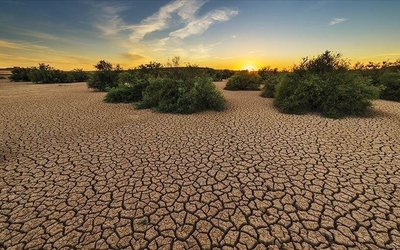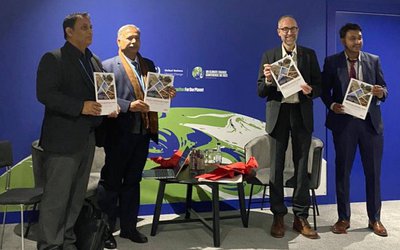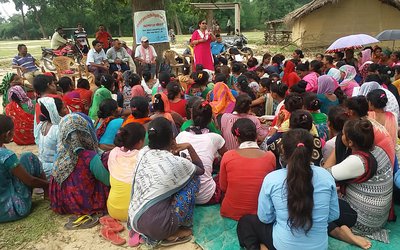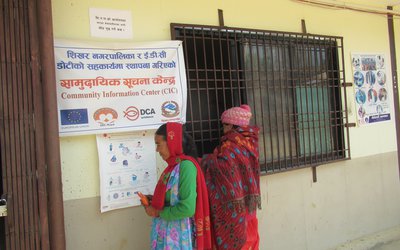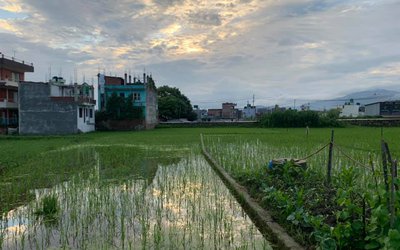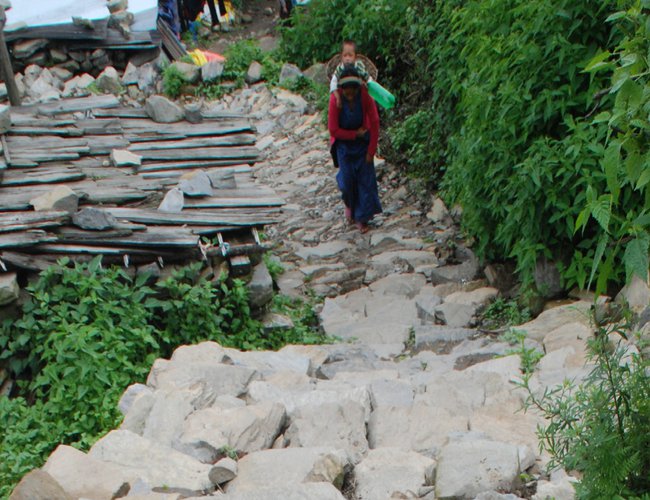
Reviving Lifeline Trails
Although foot trails and drainages received less priority in the national and provincial planning of the country, foot trails are the lifeline of remote parts of Gorkha district. The foot trails connect one village to the other and increase speed and load capacity of mule and human. After the earthquake of 2015, almost all foot trails, small irrigation, wooden bridges, roads, community schools and water taps of Laprak, Gumda, Kashigaun, Uhiya and Sirdibas either destroyed or washed away. For villagers, the destruction of these basic infrastructures was more devastating than their own shelter. As a result villages were cut off from one another. That was where the Protracted Relief Recovery Operation (PRRO) project approached to completely change the faces of remote and rural parts of earthquake affected villages of northern Gorkha.
The Lutheran World Federation (LWF) Nepal in partnership with UNWFP and Primate’s World Relief and Development Fund (PWRDF), Canada implemented PRRO; the first and second phase of Food for Asset (FfA) and Cash for Asset (CfA) projects. It supported food insecure households in the rural remote northern parts through a local partner Goreto-Gorkha.
Along with the local stakeholders, elected representatives of Gorkha also hailed the contribution made by PRRO projects as the project is in the last stage of completion. Chairperson of District Coordination Committee (DCC) Gorkha, Ashok Kumar Gurung, who has inspected a number of projects and interacted with the local people of project sites, viewed PRRO as a successful model of community user groups, social organizations, development partners and Elected Representatives working together.
“The projects implemented in the remote parts of Uhiya, Laprak and Sridibas showed how effective coordination among the local elected leaders, beneficiaries and local NGOs and INGOs brings tangible changes in the life of people,” said Gurung who coordinates the programs and projects among local bodies Implemented by local NGO Goreto-Gorkha under PRRO II with support from LWF Nepal, PWRDF and UNWFP, the reconstruction and of trails, drainage, bridges, community buildings and water taps helped to enhance the life of local community.
Elected fifteen months ago, Chairperson Gurung, inspected the revived infrastructure like foot trails, wooden bridge, community buildings, drainage, water taps, irrigation canals and public toilets. He said that these infrastructures are earthquake resilient and the Build Back Better Model will contribute to improve the livelihood of the people. Gurung also visited sites where the reconstruction is still ongoing.
Gurung got a positive impression about the project’s work when he visited a drainage constructed in Laprak. “I saw a reconstruction of drainage over the road which redirected the water to river, preventing possible landslides in the human settlement. This made me realize how a small intervention can prevent major disasters.”
“The people’s ownership of the project was ensured because it involved beneficiaries and local stake holders in the process of planning, selection and implementation,” said Gurung. “With the involvement of all stake holders, the project follows accountability and transparency parts. Truthfully, there are more demands for projects like this from the remote villages like Uhiya and Sirdibas Rural Municipality of Gorkha district.”
Chairperson Gurung holds the view that modality like food for asset and cash for asset are best suited in the villages. They fulfilled the demands of food for the food insecure local communities and cash based intervention helped local population to generate money required to fetch other necessary goods.
“After earthquake, many projects were implemented in Gorkha by different organizations for reconstruction of houses, schools and livelihood support. I found PRRO has secured a special place in the hearts and minds of people,” said Gurung,. “When I inspected some of the projects and interacted with our elected representatives and local community about the outcome, I found that people and elected representatives have owned it as their own programs.”
Gurung, who visited several other earthquake related projects implemented in the district, said PRRO has shown that there are plenty of spaces for elected representatives, local beneficiaries and LWF Nepal, UNWFP, and Goreto to work together.
“We have already received requests from elected representatives of Rural Municipality of Laprak and Uhiya to continue PRRO project in the region for a certain time,” said Gurung. “During the implementation of PRRO I and PRRO II, many local infrastructures were reconstructed.”
Projects come and go. However, some projects have left a long lasting impact. People were also found to be concerned about strong and earthquake resilient reconstruction.
The five project implementing sites are situated in two northern Rural Municipalities’ i.e. Chunumbri and Darche. The villages Sirdibas, Uhiya and Kashigaun villages are highly food insecure remote villages whereas Gumda and Laprak are found remotely located villages with improved food security situation but they have not returned to normalcy.
According to a study conducted by LWF Nepal, a total of 2,747 households are benefitted and about 12,361 populations ensured their food and nutrition through direct food and cash support during lean seasons. This was the time when they were in need.
People Change Plan of Going to Gulf Countries for Job
As he was waiting to get a letter from Kuwait for employment, twenty-five years old Min Bahadur Sunar, a dalit, changed his mind as he was offered a job in his own village under cash for work program. Goreto Gorkha, implemented PRRO with the support from LWF Nepal and UNWFP in Uhiya Although it was a temporary work to restore the foot trail in his village, he learned skills in earthquake resilient reconstruction. This new skill changed his mind about going for foreign employment PRRO paid him Rs 640 (approximately $ 6) but this money came with a skill.
Discouraged by the lack of employment opportunities in the village, Sunar, who also taught at a primary school, holds the view that earthquake victims like him needed cash and skills. The program implemented under PRRO had both components. “We have rehabilitated many foot trails and reconstructed some wooden bridges through PRRO project. We secured employment and skill as well. In the first phase, the project provided food which was good in the given conditions,” said Sunar. “Our problem with food was that it needed a long time to fetch from nearby town Arughat, which is almost two days’ walk. Majority of farmers preferred cash because it gave them freedom to purchase the food they wanted” he added.
“After the implementation of this program, some young people from our village gave up the idea to go for foreign employment. With new skill in hand, we could make money in our own areas,” said Sunar. As a gateway to Manasalu Himal, local people like Sunar expect, the newly rehabilitated foot trails can lure large numbers of people this year. “If the number of tourists increases this year, the village will generate employment opportunities in our own areas through ‘home stay,” said Sunar.
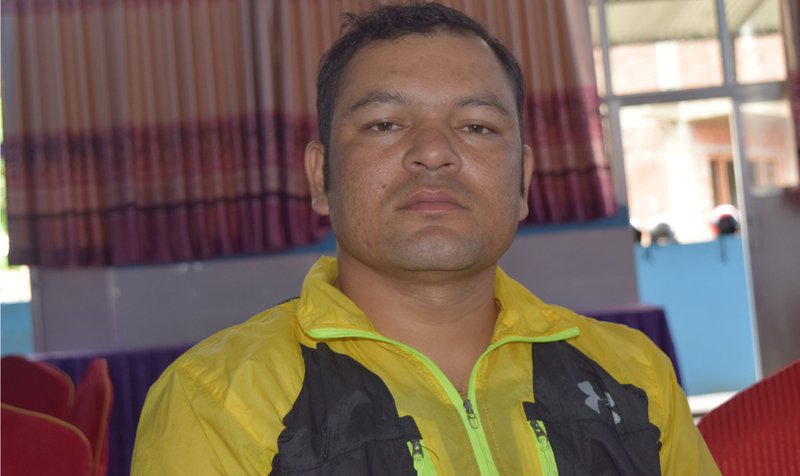
Sunar was not alone many others have benefited from the first and second phase of food for Asset (FFA) and Cash for Asset (CFA) projects implemented by LWF Nepal in partnership with UNWFP and PWRDF supporting food insecure households in the target area through a local partner Goreto-Gorkha.
Based on the success, lessons learned and strength of the first phase, the second phase was designed to create employment opportunities for food insecure earthquake affected households of Gorkha district through Cash for Asset (CfA).
Like Sunar each household should work for 40 days and only one person per household can be involved directly in the assets creation activities.
According to project final report, after the completion for first 20 days, each household was entitled for 75 kilograms of rice and 13.5 kilograms of yellow spited beans (YSP) or NRP 12,800 depending upon the assets creation modality in the respective ward. Similar amount of second entitlement was distributed after the completion of remaining 20 days of assets creation activities.
The project “Restoring Food & Nutrition Security and Building Resilient Livelihoods in Earthquake Affected Areas” in the earthquake-hit communities in 5,500 households have benefitted so far, LWF is now working to support 1,708 households in the villages of Kashigaun, Uhiya, and Sirdibas of Gorkha district.
Organic Farming Pays To Rita Bajgai
Even though they have been producing organic products for the last ten years,Rita Bajgai, 44, a single woman, has learnt better skills and techniques recently. Her house is just over 25 kilometers south of capital Kathmandu, Pokhari Chaur of Bhattedanda of Bagmati Rural Municipality but it is still remote in terms of transport connectivity.
Mother of two children, Bajgai found the year 2015 too painful for her as earthquakes demolished her home and buried food items and cattle. Her recovery was gradual as it took her almost three years to reconstruct a two room house and move from a temporary to permanent shelter.
A subsistence farmer Bajgai invested a small saving to reconstruct the house as she was desperately searching some kind of support to maximize her income. “As a farmer, we don’t know other skills than farming and cattle rising. However, it is impossible to maximize the income without investment,” said Bajgai.
For the desperately poor earthquake victims like Bajgai the implementation of Sustainable Integrated Farming System (SIFS) of LWF-Nepal with local partner ICDO came as a savior. As she was searching for some investment for her sustainable livelihood, SIFS through ICDO’s local partner Satkanya Multiple Cooperative Society Ltd, Bhattedanda came with support in kind necessary for organic farming. After Bajgai was selected for the grant, she secured membership of the cooperative. The cooperative provided her two plastic water tanks, one to collect urine of cattle and one for collection of water, drip irrigation equipment and sprayer equivalent to Rs 20,000 last year.
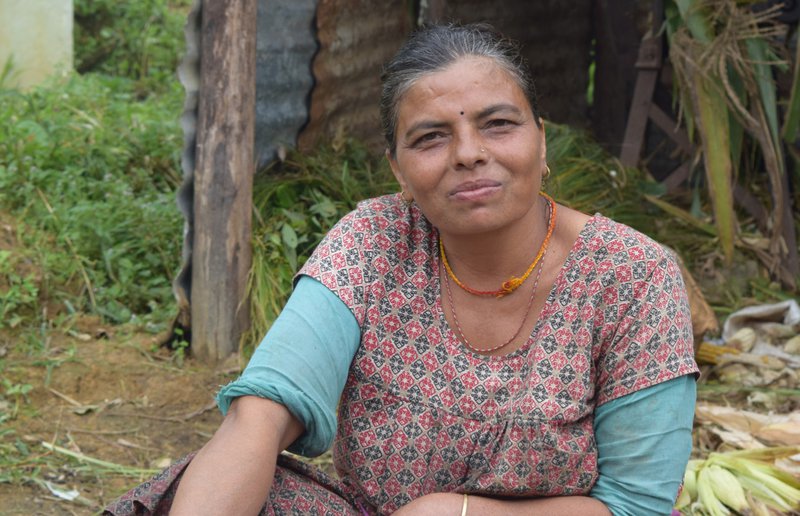
Although this support was small, it helped her double her earning from agriculture and livestock. With three buffalos, five goats and a cow, Bajgai had enough manure for organic production.
Along with this, ICDO also provided training for Bajgai to make cow manual and organic-pesticide. “Although Iused chemical fertilizers and pesticide in past, I don’t use it in my farm now a days. I save almost Rs 3000 to Rs 4000 annually,” said Bajgai.
From going nearly bankrupt, Bajgai is now selling 12 liters of milk daily and almost Rs 15000 equivalent of vegetables like cucumber, pumpkin, brinjal, mustard leaf and okra. “Targeting Dashain festival, I have already planted cauliflower and cabbage. If everything goes right, I can produce the vegetables worth over Rs 20,000,” she further said
After implementation of the project, 138 households improved their SIFS model, Bhakaro Sudhar, improved compost manure, tunnel for vegetable production and technical support through technical staffs (JTAs) inputs.
The project also established well managed compost manure pit for three households headed by one male and two females of three wards of project area.
Cooperatives Teaches Marketing Mechanism
From early in the morning to late evening, Laxmi Ghimire, 40, manager of Satkanya Multiple Cooperatives (SMC) Bhattedanda, goes from house to house meeting with other women members.
“My life cycle is going this way for the last three years. After the implementation of the project, I have more to do,” said Ghimire, who has been spending her entire days to visit pockets and interacting with women farmers.
With programs in several pockets, as local partner of LWF Nepal and ICDO, the cooperatives have to provide necessary support to the stake holder of sustainable integrated farming System, Tunnel with Seasonal farming, shed management, compost management and liquid pesticide.
Along with this, the cooperatives also have to work to establish the linkage between the farmers and markets.
On August 31, fourteen women representing board of SMC and members of Market Management Committee decided to set up a market recommending to final negotiation with District Agriculture Office (DAO) and Ward Office.
With the middlemen taking more profits than the farmers, the demand is growing over the establishment of a market to buy and sell the vegetables and other agriculture products in fair prices. As a main lender of women farmer, SMC is taking the lead role. Under a program, SMC has been organizing a series of meetings and consultations.
Holding meeting, encouraging women to get involved in productive sector and linking them with the market is the work of Ghimire. SMC is given responsibility to set up a market in nearby areas and has formed a committee among its members.
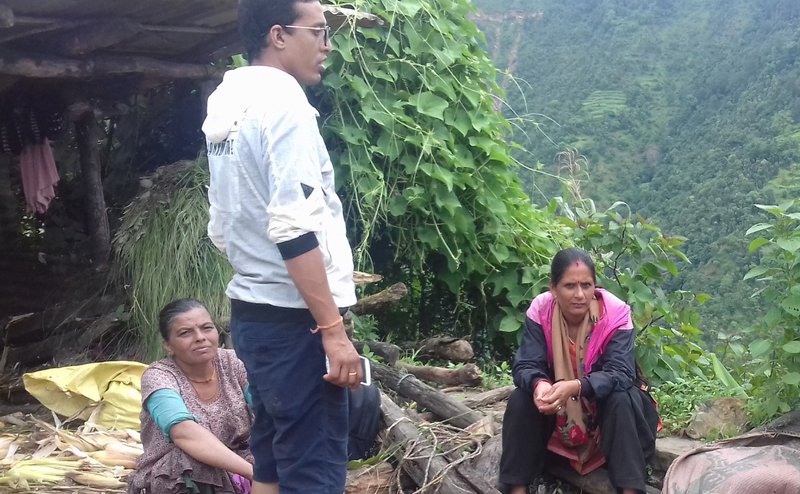
At a time when farmers are getting less for their productions due to lack of entrepreneur skills and knowledge, one of the aims of the SIFS is to improve entrepreneurial skills of earthquake affected small land-holders farmers and enhance their access to market for small land-holders products. And the cooperatives like SMC are to play a key role. Here comes the role of manager Ghimire, who has to summon the meeting of all stake holders.
Laxmi spends her entire month visiting from one pocket to other meeting farmers and knowing their problems and need. If women need any kind of loan for the product, Ghimire has authority to issue up to Rs 100,000.
“These are the hectic days. I have to visit house to house to know the state of our members and lenders. One of the major challenge for me is to establish linkage between farmers and market. As women farmers, our members, DADO and Ward chair have already agreed to open the famers market in Bhattedanda, farmers will get the genuine price of their products,” said Ghimire. “We take decision with the consultation of the people and we distribute the things through our system, there involves transparency, accountability and good governance practices,” said Ghimire.
“In the recent meeting of Market Committee, Cooperative, ward and District Agriculture Office all agreed to open the market within two months,” said Ghimire. “If we are able establish direct linkage between market and farmers, it will be another milestone in the agriculture,” said Ghimire. This is what LWF Nepal and its partner also prefer.
Not only SMC, two other Cooperatives associated 107 households with 22 male
Food for Work (FFW) Project Makes Food Deficit To Food Sufficient
The residents of northern parts of Rasuwa, a food deficits region, used to migrate for work to Kathmandu and other places to fulfill their needs. The earthquake of 2015 has made the situation much worse.
After earthquake in 2015, Pemba Dolma of Pajung, a resident of Chilime-7, lost everything. His house was completely demolished and food grains inside the home were buried.
For months he survived in a temporary shelter and on food donated from various organizations. As the new harvest came in September, he was a little relief. However, it did not last long.
After a few months of relatively good state, Dolma again faced the crisis. However, the implementation of food for work project in 2016 with the support from Canadian Food Grains Bank, PWRDF and LWF Nepal gave Dolma a respite. Implemented by MANEKOR Society Nepal, the project supported Gatlang, Golgunj and Chilime Village of the district, under food for work.
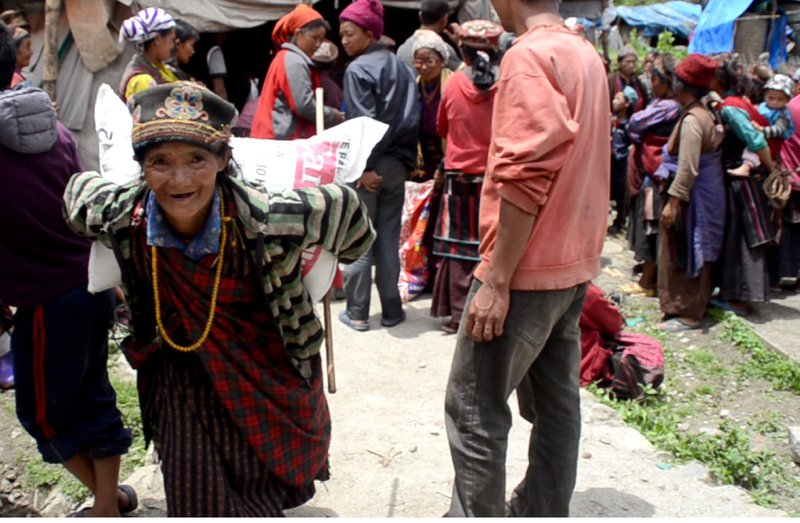
“I do not need to borrow money from others to feed my family for at least these three months,” said Pemba. Under the program, he was given enough food to feed my family. Fifty one year old Mrs. Pemba Dolma, one of the beneficiaries from Chilime-7, shared her happiness working in FFW project. Currently living with her two sons, all three family members participated in this project and helped to construct agriculture road and foot trail.
This helped in easy movement from Pajung to Chilime Village. In return, she reported that she received 2 liters of oil, 4.5 kg pulse and 30 kg rice once in every 15 days and 1 KG of salt for entire project interval of 45 days.
“The received food item has helped me to address food shortage during lean season. After FFW project, my family did not have to borrow money from other.
- MELAMCHI WATER SUPPLY: No Interruption During Monsoon
- Jun 25, 2025
- KOREAN RETURNEES: Successful Integration
- Jun 25, 2025
- UPPER TRISHULI-1: Engaging With Local
- Jun 25, 2025
- IME GROUP: Twenty Five Years Of Journey
- Jun 24, 2025
- NEPAL’S AIR POLLUTION: A Growing Health Concern
- Jun 24, 2025

